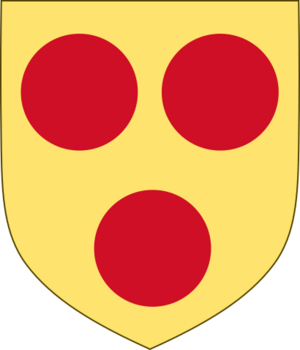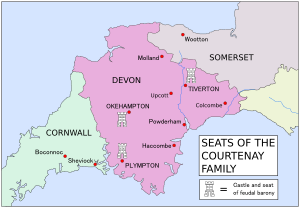House of Courtenay facts for kids
| House of Courtenay |
|||
|---|---|---|---|
Quick facts for kids  Arms of the House of Courtenay |
|||
| Country: | |||
| Titles: | *Latin Emperor of Constantinople
|
||
| Founder: | Athon of Courtenay | ||
| Current Head: | Charles Courtenay, 19th Earl of Devon | ||
| Founding Year: | c. 11th | ||
| Ethnicity: | French | ||
| Cadet Branches: | *Capetian House of Courtenay
|
||
The House of Courtenay was a powerful noble family in the Middle Ages. They had branches in France, England, and the Holy Land. One part of the family, the Capetian Courtenays, became a royal house. They were cousins to the Bourbon and Valois families. They even held the title of Latin Emperor of Constantinople.
Contents
The beginnings of the Courtenay family
The Courtenay family began with Athon. He was the first lord of Courtenay in France. Athon took advantage of a power struggle in the Duchy of Burgundy. He captured land and created his own lordship, or seigneury. He named his family after the town he founded and made strong.
Athon's son, Joscelin, took over after him. Joscelin had three sons. Miles became Lord of Courtenay. Prince Joscelin joined the First Crusade. He became the Count of Edessa in the Holy Land. His brother Geoffrey also fought there and died.
In the 12th century, Reginald de Courtenay (died 1190) had a disagreement with King Louis VII of France. Reginald moved to England. His French lands were taken away. They passed to King Louis' brother, Peter, who then took the name "Peter de Courtenay." Peter's son, Peter II, later became the Latin Emperor of Constantinople.
The Crusader Courtenay family
Joscelin de Courtenay arrived in Outremer (the Crusader states) during the third wave of the First Crusade. He proved to be a skilled leader. He became Lord of Turbessel, then Prince of Galilee. In 1118, he became Count of Edessa.
His son, Joscelin II, took over in 1131. However, the county of Edessa was lost in 1144. Joscelin II died in prison in 1159.
His son, Joscelin III, was the Count in name only. His sister, Agnes, became Queen of Jerusalem. She married King Amalric. Joscelin III died in the 1190s. His remaining land went to the Teutonic Order. Agnes was the mother of two rulers: King Baldwin the Leper and Queen Sibylla.
The English Courtenay family
Reginald de Courtenay's grandson, Robert de Courtenay (died 1242), was a powerful landowner in Devon, England. He married Mary de Redvers. She was the daughter and heir of William de Redvers, 5th Earl of Devon. The Redvers family lived at Tiverton Castle and Plympton Castle in Devon.
When Isabel de Forz, the 8th Countess of Devon, died in 1293, her cousin Hugh de Courtenay (died 1340) took over. He became the 1st or 9th Earl of Devon. The exact numbering is debated by historians.
The main line of the English Courtenay family died out in 1471 during the Wars of the Roses. However, the title of Earl of Devon was given to cousins three more times. These cousins were all related to the earlier Earls. William Courtenay, 1st Earl of Devon (1475–1511) married Princess Catherine. She was a daughter of King Edward IV. This marriage brought the Earls of Devon very close to the English throne.
The title of Earl of Devon was thought to have ended in 1556. But in 1831, it was decided that the title was only "dormant" (sleeping). It was then given to William Courtenay (1768–1835). His family lived at Powderham Castle in Devon. The Courtenay family continues to this day. The current head is Charles Courtenay, 19th Earl of Devon.
The Capetian House of Courtenay
Reginald de Courtenay's daughter, Elizabeth, married Peter of France (died 1183). He was the youngest brother of the French King Louis VII. King Louis gave Elizabeth her father's French lands. Peter then became known as Peter I of Courtenay.
Peter and Elizabeth's children were part of the Capetian House of Courtenay. This was a "cadet branch" of the House of Capet. A cadet branch is a younger line of a royal family. Through marriage, their descendants gained control of the County of Namur and the Latin Empire of Constantinople. This branch of the family ended in 1733. The Courtenay name then passed to the Princely House of Bauffremont.
Claim to French royal status
The House of Bourbon became the ruling family of France in 1589. They were another cadet branch of the Capetian dynasty. Under French law (called Salic law), male descendants of Hugh Capet were considered "princes of the blood." This meant they could become king if the main royal family line died out.
The Capetian Courtenay family was not rich. But they were direct male descendants of Louis VI of France. They wanted to be recognized as "princes du sang" (Princes of the Blood Royal). This title gave them important seats on the Royal Council and in the Parliament of Paris.
The Bourbon kings, including Henry IV, Louis XIII, and Louis XIV, refused their requests. The Bourbons wanted to limit who could be considered royal. For example, the Treaty of Montmartre (1662) named the House of Lorraine as next in line to the French throne after the Bourbons. This skipped over the Courtenay family, even though they were Capetians. The Courtenays protested, but their claims were never accepted.
The last male member of the French Courtenays died in 1733. His niece married the marquis de Bauffremont. Their descendants took the title "Prince de Courtenay." This title's legality was questioned. However, the marquis de Bauffremont was made a Prince of the Holy Roman Empire in 1757. This title was recognized in France. The Bauffremont-Courtenay family still exists today.
Key family members
Here are some important people from the Courtenay family:
- Athon: The founder of the family.
- Joscelin I, Lord of Courtenay: Athon's son, who continued the family line.
- Reginald de Courtenay: Moved to England and started the English branch.
- Peter I of Courtenay: Married Elizabeth de Courtenay and started the Capetian branch in France.
- Joscelin I, Count of Edessa: A Crusader who became Count of Edessa in the Holy Land.
- Joscelin II, Count of Edessa: Joscelin I's son, who lost the County of Edessa.
- Joscelin III of Edessa: The last titular Count of Edessa.
- Agnes of Courtenay: Queen of Jerusalem, mother of two monarchs.
- Hugh de Courtenay, 9th Earl of Devon: The first Courtenay to be recognized as Earl of Devon in England.
- William Courtenay, 1st Earl of Devon: Married Princess Catherine of York, connecting the family to the English royal line.
- Charles Courtenay, 19th Earl of Devon: The current head of the English Courtenay family.
See also
 In Spanish: Casa de Courtenay para niños
In Spanish: Casa de Courtenay para niños




